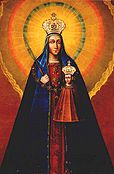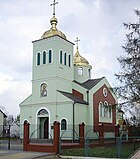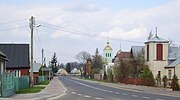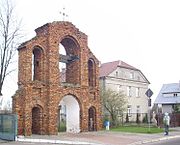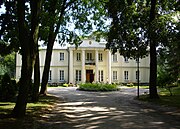Codeń
| Codeń | ||
|---|---|---|
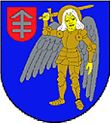
|
|
|
| Basic data | ||
| State : | Poland | |
| Voivodeship : | Lublin | |
| Powiat : | Bialski | |
| Gmina : | Codeń | |
| Geographic location : | 51 ° 55 ' N , 23 ° 36' E | |
| Residents : | 1800 (2011) | |
| Postal code : | 21-509 | |
| Telephone code : | (+48) 83 | |
| License plate : | LBI | |
Kodeń is a village and the seat of the rural municipality of the same name in the Powiat Bialski of the Lublin Voivodeship in Poland .
geography
Kodeń is located on the western bank of the Bug , which forms the border with Belarus here.
history
In 1511 Jan Sapieha , who became voivode of the newly founded Lithuanian Podlaskie Voivodeship in 1513 , bought the settlement. He had it fortified, expanded into a city under Magdeburg law and built a castle, which was then the seat of his family for centuries. In 1569 Poland and Lithuania were merged into a real union ( Union of Lublin ). In the Union of Brest , the Lithuanian Orthodox Church submitted to the Pope in 1596.
With the Third Partition of Poland in 1795, Kodeń came to the Habsburg Empire , during the period of French hegemony under Napoleon in 1807 to the Duchy of Warsaw under Friedrich August of Saxony and at the end of 1815 to Congress Poland . Initially linked with the Russian Empire in personal union, then annexed in 1831 as the ten Vistula governorates. Kodeń now belonged to the Siedlce Governorate .
After the end of the First World War , Kodeń was in an area that was disputed between the Polish Republic , proclaimed on October 7, 1918 and recognized by the Treaty of Versailles, practically in June 1919 and formally on January 10, 1920, and the Ukrainian, proclaimed in 1917 People's Republic , whose territory was in turn claimed by Soviet Russia . With the Riga Peace Treaty of 1921 , Kodeń was definitely part of the Second Polish Republic. During the Second World War, after the German occupation of Poland, it was in the General Government .
local community
The rural community (gmina wiejska) Kodeń includes 16 villages with 19 school offices (sołectwo) .
Attractions
- Kościół Świętego. Ducha (Catholic Church of the Holy Spirit), around 1550, Belarusian Gothic , originally an Orthodox castle chapel of Sapieha, since 1945 a branch church of the Catholic St. Anne's parish
- Ruins of the ancient Sapieha castle
-
Bazylika św. Anny (St. Anne's Church), 1629–1635, Renaissance and Baroque , Catholic parish church, 1875–1917 Orthodox, since 1973 minor basilica
- Icon of the Mother of God, around 1630, in St. Anne's Church
- Monastery of the Oblate Order , which looks after the St. Anne's Church
- Brama unicka ( Uniate Gate), west gable of the Uniate St. Michael's Church, which burned down in the 19th century
- Placencja Palace, summer residence of the Sapieha, 18th century, rebuilt several times, today a psychiatric clinic
- Cerkiew Świętego Ducha , 1910, (St. Michael's Orthodox Church), today's Orthodox parish church
- Way of the Cross with sculptures by Tadeusz Niewiadomski , which recall the horrors of the Second World War
- Kodeń wind turbine



